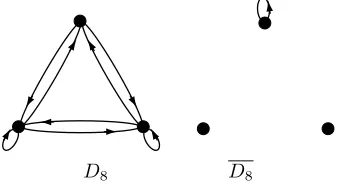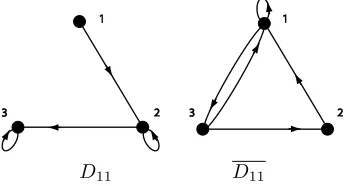THEQ-MATRIX COMPLETION PROBLEM∗
LUZ MARIA DEALBA†, LESLIE HOGBEN‡, AND BHABA KUMAR SARMA§
Abstract. A realn×nmatrix is aQ-matrix if for every k= 1,2, . . . , nthe sum of allk×k principal minors is positive. A digraphD is said to have Q-completion if every partial Q-matrix specifyingDcan be completed to aQ-matrix. For theQ-completion problem, sufficient conditions for a digraph to haveQ-completion are given, necessary conditions for a digraph to haveQ-completion are provided, and those digraphs of order at most four that haveQ-completion are characterized.
Key words. Partial matrix, Matrix completion,Q-matrix,Q-completion, Digraph.
AMS subject classifications.15A48, 05C50.
1. Introduction. A realn×nmatrixA is aP-matrix (P0-matrix) if for every
k= 1,2, . . . , n, all thek×kprincipal minors are positive (nonnegative). A realn×n
matrix A is a P0+-matrixif for every k = 1,2, . . . , n, all the k×k principal minors
are nonnegative and at least one principal minor of each order is positive. A real
n×n matrix A is a Q-matrix if for every k = 1,2, . . . , n, Sk(A)>0, where Sk(A) denotes the sum of allk×k principal minors. Clearly the set ofP0+-matrices is the intersection of the set ofP0-matrices with the set ofQ-matrices, and everyP-matrix is
aP0+matrix. Spectral properties ofQ-matrices and other related classes are discussed
in [5], [6] and [7].
Apartial matrix is a square array in which some entries are specified, while others are free to be chosen. A partial matrixB is apartialP-matrixif every fully specified principal submatrix of B has positive determinant. In many cases, the pattern of specified entries is sufficient to guarantee that any partialP-matrix with this pattern of specified entries can be completed to aP-matrix, and the (combinatorial)P-matrix completion problem involves the study of such patterns. Patterns of entries are usually described by digraphs (see Subsection 1.1). The P-matrix completion problem has been studied (e.g., [10], [4]); for a discussion and bibliography of completion problems
∗Received by the editors December 20, 2007. Accepted for publication February 25, 2009.
Han-dling Editor: Bryan L. Shader.
†Department of Mathematics and Computer Science, Drake University, Des Moines, IA 50311,
USA ([email protected]).
‡Department of Mathematics, Iowa State University, Ames, IA 50011, USA ([email protected])
and American Institute of Mathematics, 360 Portage Ave, Palo Alto, CA 94306 ([email protected]).
§Department of Mathematics, Indian Institute of Technology Guwahati, Guwahati, Assam 781039
India ([email protected]).
ofP-matrix classes see [8] and [9].
We can define a partialQ-matrix in a similar way: A partial matrixBis apartial Q-matrixifSk(B)>0 for everyk= 1,2, ..., nfor which allk×kprincipal submatrices are fully specified. A more useful characterization of a partialQ-matrix is given in Proposition 2.1.
1.1. Digraphs. Most of the following graph-theoretic terms can be found in any standard reference, such as [1], [13], or [14] (note that graph terminology varies with the author: what we call a digraph is called a simple digraph in [14]). Adigraph D= (VD, AD) consists of a non-empty finite setVDofverticesand a setADof ordered pairs of vertices, called arcs. Theorder ofD, denoted|D|, is the number of vertices of D. A digraph H = (VH, AH) is a subdigraph of a digraph D if VH ⊆ VD and
AH ⊆AD. A subdigraph H = (VH, AH) of D= (VD, AD) is an induced subdigraph
if AH = (VH×VH)∩AD; in this case we also denote H by D[VH]. A subdigraph
H of digraphD is aspanningsubdigraph ifVH=VD. Thecomplementof a digraph
D = (VD, AD) is the digraph D = (VD, AD), where (v, w) ∈ AD if and only if (v, w) ∈/ AD. A digraph D is symmetric if (v, w) ∈ AD implies (w, v) ∈ AD. A
complete digraph on n vertices, denoted Kn, is a digraph having all possible arcs (including all loops).
A path P in a digraph D is a subdigraph ofD whose distinct vertices and arcs can be written in an alternating sequence
v1(v1, v2)v2(v2, v3)v3, . . . , vk−1(vk−1, vk)vk.
This path is also written asv1 →v2→ · · · →vk. Ifv1→v2→ · · · →vk is a path in
D and (vk, v1) is also an arc in D, then v1 →v2 → · · · →vk together with (vk, v1)
is acycle. Thelengthof a path P (respectively, cycleC), denoted|P|(respectively,
|C|), is the number of its arcs. Ak-cycleis a cycle of lengthk; a 1-cycle (i.e., an arc (v, v), v∈VD) is generally called aloop.
It is useful to associate a partial matrix with a digraph that describes the positions of the specified entries in the partial matrix. Letn ={1,2, . . . , n}. We say that an
n×npartial matrix B specifiesa digraphD ifD = (n, AD), and for 1≤i, j≤n,
(i, j)∈AD if and only if the entrybij ofB is specified.
There is another way to associate a digraph to a (complete) matrix that describes the positions of the nonzero entries of the matrix; this association is particularly useful when studying Q-completions of families of matrices with certain specified entries. The digraph of an n×n matrixA is D(A) = (n , AD(A)) where AD(A) = {(i, j) :
aij= 0}. Given a digraphD, theadjacency matrixofDis the (0,1)-matrixA= [aij] havingaij = 1 if (i, j)∈AD andaij = 0 if (i, j)∈/ AD.
Letπbe a permutation ofV. Apermutation digraphis a digraph of the formDπ= (V, Aπ) where Aπ ={(v, π(v)) : v ∈V}. Clearly each component of a permutation digraph is a cycle.
Observation 1.1. ([2, p. 292]). Let Abe an n×n matrix. Then
det(A) =(sgnπ)a1π(1)· · ·anπ(n)
where the sum is taken over all permutations π of n such that Dπ is a spanning subdigraph of D(A), and the sum over the empty set is zero.
Apermutation subdigraphof a digraphDis a permutation digraph of a subdigraph ofD. A digraphDisstratifiedifDhas a permutation subdigraph of orderkfor every
k= 2,3, . . . ,|D|.
1.2. Signed digraphs and SNS matrices. A signing of a digraph is an as-signment of a sign (+ or−) to each arc of the digraph; the sign of arc (v, w) is denoted sgn(v, w). The result of a signing is called asigned digraph. Thesigned digraphD±(A)
of a real square matrixAis obtained fromD(A) by assigning sgn(aij) to arc (i, j).
Theproduct of the cycleC=v1→v2→ · · · →vk→v1 in a signed digraph is
sgn(v1, v2)· · ·sgn(vk−1, vk)sgn(vk, v1),
and thesign of the cycleC=v1→v2→ · · · →vk →v1 is
sgn(C) = (−)k+1sgn(v
1, v2)· · ·sgn(vk−1, vk)sgn(vk, v1).
Note that what we have called the product of a cycle is called the sign of a directed cycle in [3], and in that book the digraph or signed digraph of a matrix does not have loops.
Ann×nreal matrixAdetermines thequalitative classQ(A) consisting of all real matricesB such that for alli, j = 1, . . . , n,sgn(bij) = sgn(aij). A real square matrix
Theorem 1.2. [3, Theorem 1.2.5] A real square matrix A is an SNS matrix if and only if every nonzero term in the standard determinant expansion of A has the same sign and there is a nonzero term in the determinant.
Theorem 1.3. [3, Theorem 3.2.1]A real square matrixAthat has every diagonal entry negative is an SNS matrix if and only if every cycle product of D±(A)is equal to−.
Since−Ais an SNS matrix if and onlyAis an SNS matrix, we have the following positive equivalent.
Corollary 1.4. A real square matrix A that has every diagonal entry positive is an SNS matrix if and only if the sign of every cycle ofD±(A)is+.
The ability to sign a digraph so that the sign of every cycle is + is an important tool in finding a Q-completion for certain digraphs (see Section 2.1). By Corollary 1.4, the question of whether a digraph D has such a signing is equivalent to the following question about the adjacency matrixA of D: Is there a (0,1,−1)-matrix
B such that|B|=A, and the matrix B1, obtained by replacing every diagonal entry
of B by 1, is an SNS matrix? Since such a matrix B can be used to convert the problem of computing the permanent of any matrix having the zero pattern ofAto the problem of computing the determinant of a matrix having sign pattern B, B is called aconversionofAandAis calledconvertible[3, p. 141]. In [12] it is shown that the question of whether a matrix is convertible can be answered in polynomial-time.
1.3. Overview. In this paper we study the following (combinatorial)Q-matrix completion problem: Determine which digraphs have the property that every partial
Q-matrix specifying the digraph can be completed to aQ-matrix. That is, determine which digraphs have Q-completion. Our main results are presented in Section 2. Specifically, we establish some sufficient conditions for a digraph to haveQ-completion (Subsection 2.1) and some necessary conditions for a digraph to have Q-completion (Subsection 2.2). In Subsection 2.3 we classify digraphs of order at most four as to
Q-completion.
The property of being aQ-matrix is preserved under similarity and transposition, but it is not inherited by principal submatrices, as can easily be verified. Thus the
Q-matrix completion problem is quite different from completion problems involving
2. PartialQ-matrices and theQ-matrix completion problem. Recall that a partial matrixB is a partialQ-matrix ifSk(B)>0 for everyk= 1,2, ..., nfor which all k×k principal submatrices are fully specified. Note that if all 1×1 principal submatrices of B are fully specified (i.e., all diagonal elements are specified), then Tr(B)>0. If for somek≥2, allk×kprincipal submatrices are fully specified, then
B is fully specified (and thereforeB is aQ-matrix). Thus the following proposition, which provides a more useful characterization of partialQ-matrix, is immediate.
Proposition 2.1. A partial matrixB is a partialQ-matrix if and only if exactly one of the following holds:
(i) at least one diagonal entry of B is not specified,
(ii) all diagonal entries ofBare specified,Tr(B)>0, and at least one off-diagonal entry of B is not specified,
(iii) all entries ofB are specified andB is aQ-matrix.
2.1. Sufficient conditions for Q-completion. Notice that if B specifies the digraphD, then the entries inB in positions described byD are free to be chosen to completeB. In the next example we use the idea of signing cycles positively inDto obtain a completion to aQ-matrix.
Example 2.2. Let D1 be the digraph in Figure 2.1. We sign the arcs of D1
1 2
3 4
1 2
3 4
[image:5.612.177.336.424.518.2]D1 D1
Fig. 2.1.The digraphD1 hasQ-completion
as follows: sgn(1,3) = sgn(2,4) = + and sgn(3,1) = sgn(4,2) =−. Then the sign of each of the two 2-cycles inD1is +. For a partialQ-matrix
B=
b11 b12 x13 b14
b21 b22 b23 x24
x31 b32 b33 b34
b41 x42 b43 b44
specifyingD1, define the completionA(t) ofB by choosing each unspecified entry to
be the sign of its arc timest, i.e.,x13=x24=t, x31=x42=−t. Then
S1(A(t)) =b11+b22+b33+b44,
S2(A(t)) = 2t2+q2(t) where degq2(t)≤1,
S3(A(t)) = (b11+b22+b33+b44)t2+q3(t) where degq3(t)≤1,
S4(A(t)) =t4+q4(t) where degq4(t)≤2.
SinceBis a partialQ-matrix,b11+b22+b33+b44>0. Therefore, fortlarge enough,
Sk(A(t))>0 for allk= 1,2,3,4.
Theorem 2.3. Let D be a digraph such that D is stratified. If it is possible to sign the arcs ofD so that the sign of every cycle is+, thenD has Q-completion.
Proof. Given a partialQ-matrixB, a completion A(t) is constructed by setting the unspecified entryxij = sgn(i, j)t(using the sign of the arc inD). Then for each
k= 2, . . . , n,
Sk(A(t)) =cktk+qk(t)
where ck is the number of permutation subdigraphs of order k in D and qk(t) is a polynomial of degree less thank. IfDcontains all loops, then the trace of any partial
Q-matrix specifyingD is positive; ifDomits a loop, then S1(A(t)) =c1t+q0, where
c1 is the number of loops in Dand q0∈R. So choosingt sufficiently large results in
aQ-matrix.
The next theorem shows thatQ-completion is inherited by spanning subdigraphs of any digraph that is not complete and hasQ-completion.
Theorem 2.4. If D is a spanning subdigraph of an order n digraph Dˆ = Kn that has Q-completion, thenD has Q-completion. Equivalently, ifD is a digraph of order n, and a digraph Dˆ =Kn obtained fromD by adding one or more arcs to D has Q-completion, thenD has Q-completion.
Proof. Suppose ˆD is obtained from D by adding the one arc (i, j), ˆD = Kn, and ˆD has Q-completion (note that j = i is permitted). Let B be a partial Q -matrix specifying D. Construct a partial matrix ˆB that specifies ˆD by choosing the (i, j)-entryxij of B as follows:
xij =
0 if j=ior ˆDomits a loop 1−
k=i
Then ˆB is a partialQ-matrix, and any completion of ˆB to aQ-matrix completes B
to aQ-matrix.
We obtain the following corollary from Theorem 2.4 and Theorem 2.3.
Corollary 2.5. If D is a digraph and D has a stratified spanning subdigraph that has a signing in which the sign of every cycle is +, thenD has Q-completion.
Example 2.6. The digraphD2in Figure 2.2 hasQ-completion by Corollary 2.5,
[image:7.612.175.341.243.337.2]D2 H
Fig. 2.2.The digraphD2 and stratified spanning subdigraphH ofD2
becauseH is a stratified spanning subdigraph ofD2that can be signed so that each
cycle is + (e.g., by signing all arcs +).
If we can find a signing for D that makes the sign of every cycle +, then the digraph D hasQ-completion, and since by Corollary 2.5 we can make the problem easier by removing arcs fromD (as long as the result is still stratified), an effective strategy for finding a Q-completion is to look for a signing of a stratified subgraph of D having no arcs that can be removed. A digraph is minimally stratifiedif it is stratified and the deletion of any arc results in a digraph that is not stratified. The digraph H in Figure 2.2 is minimally stratified. However, the next example shows that it may not be possible to find a signing that makes the sign of every cycle +, even whenD is minimally stratified andD hasQ-completion.
Example 2.7. Let D3 and its complement D3 be the digraphs shown in
Fig-ure 2.3. Let
M =
0 a b 0 0
c 0 e 0 0
0 f 0 g 0 0 0 0 0 h
k 0 0 0 0
1
2
1
2
3 4
5
5
4 3
[image:8.612.163.347.101.208.2]D3 D3
Fig. 2.3.D3 is minimally stratified and impossible to sign so that the sign of every cycle is+
We use the matrixM for the determination of cycles and signing, to show thatD3 is
minimally stratified but cannot be signed so every cycle is positive, even though M
is not a Q-matrix since its trace is zero. Assuming all the parameters are nonzero,
D(M) =D3.
S2(M) =−ac−ef
(2.1)
S3(M) =bcf
(2.2)
S4(M) =−bghk
(2.3)
S5(M) =aeghk
(2.4)
Examination ofSk(M), k= 2,3,4,5 showsD3is stratified and examination ofS3(M),
S4(M),andS5(M) shows that this stratification is minimal.
To sign all cycles +, the following signs are necessary:
bcf >0 from (2.2) (2.5)
bghk <0 from (2.3) (2.6)
cf ghk <0 from (2.5) and (2.6) (2.7)
aeghk >0 from (2.4) (2.8)
acef <0 from (2.7) and (2.8) (2.9)
ac <0, ef <0 from (2.1) (2.10)
acef >0 from (2.10) (2.11)
Finally, complete a partialQ-matrixB= [bij] specifyingD3 as
A(t) =
b11 t2 −t2 b14 b15
t2 b
22 t2 b24 b25
b31 −t3 b33 t2 b35
b41 b42 b43 b44 t2
t2 b
52 b53 b54 b55
.
Then
S1(A(t)) =b11+b22+b33+b44+b55>0
S2(A(t)) =t5+q2(t) where degq2(t)≤4
S3(A(t)) =t7+q3(t) where degq3(t)≤5
S4(A(t)) =t8+q4(t) where degq4(t)≤7
S5(A(t)) =t10+q5(t) where degq5(t)≤9
So by choosing t sufficiently large we obtain a Q-completion of B. Thus D3 has
Q-completion.
2.2. Necessary conditions forQ-completion. In our examples (and some of our results) on digraphs that omit a loop and haveQ-completion,Dis stratified. The next theorem shows that for a digraphD that omits at least one loop, stratification ofD is a necessary condition forD to haveQ-completion
Theorem 2.8. Let D be a digraph of order nthat omits at least one loop. If D has Q-completion, thenD is stratified.
Proof. SupposeD hasQ-completion. Let k≥2, and assume D has no order k
permutation digraph. IfB0 is the partial matrix that specifies D with all specified
entries zero, and A is a completion ofB0, then all k×k principal minors of A are
zero, soAis not aQ-matrix. This implies thatDmust be stratified.
The converse of Theorem 2.8 is true for the examples we have checked, including all digraphs of order at most four (cf. subsection 2.3). We do not know whether it is true in general.
Question 2.9. Let D be a digraph that omits a loop such thatD is stratified. MustD haveQ-completion?
Proof. IfDhas more thann(n−1) arcs (including loops), thenDhas fewer than
n2−n(n−1) =narcs. Thus D does not contain an order n permutation digraph.
Therefore by Theorem 2.8,D does not haveQ-completion.
It is possible to find a digraphD that omits a loop, has|AD|=n(n−1), and has
Q-completion.
Example 2.11. Let D4 be the digraph shown in Figure 2.4. Then |AD4| = 3(3−1),D4is stratified, and it is easy to signD4so that all cycles are positive. Thus
D4 hasQ-completion.
[image:10.612.170.342.245.339.2]D4 D4
Fig. 2.4.An order 3 digraph that hasQ-completion and has 6 arcs
In the case of a digraphD that contains all loops, it is not necessary thatD be stratified, as can be seen by considering the digraph D1 in Example 2.2. The next
theorem gives a necessary but not sufficient condition for a digraph containing all loops to haveQ-completion.
Theorem 2.12. Let D =Kn be an order n digraph that includes all loops and has Q-completion. Then for eachk= 2,3, . . . , n, either
(i) D has a permutation digraph of orderk, or
(ii) for eachv∈VD, D−v has a permutation digraph of orderk−1.
Proof. Letk≥2, and assumeD has no orderk permutation digraph and there exists a vertex v ∈VD such that D−v does not have an order k−1 permutation digraph. Let B be a matrix that specifies D, with bvv = 1 and all other specified entries equal to zero, and suppose Ais a completion of B. Then all k×kprincipal minors ofAare zero, and thus,Ais not aQ-matrix.
The converse to Theorem 2.12 is false, as the next example demonstrates.
Example 2.13. Let D5 be the digraph shown in Figure 2.5. Then D5 has
a permutation digraph of order 2, soD5 satisfies the conclusion of Theorem 2.12.
1
2
3 4
5
1
2
3 4
5
[image:11.612.155.350.130.238.2]D5 D5
Fig. 2.5.A counterexample to the converse of Theorem 2.12
However, the partialQ-matrixB=
2 0 x y 0 0 2 0 0 w
u 0 2 0 v
0 t 0 −7 0 0 r s 0 2
specifiesD5and cannot
be completed to aQ-matrix, because the sum of the 2×2 principal minors is−32− sv−rw−ux, forcingsv+rw+uxto be negative but the sum of the 3×3 principal minors is−136 + 3sv+ 3rw+ 3ux, forcingsv+rw+uxto be positive.
Corollary 2.14. Let D = Kn be an order n digraph that includes all loops and such that D has more than (n−1)2−1 non-loop arcs. Then D does not have
Q-completion.
Proof. If D has more than (n−1)2−1 non-loop arcs, then D has fewer than
n(n−1)−(n−1)2+ 1 =narcs. ThusD does not contain an order npermutation
digraph and contains at most one order n−1 permutation digraph. Therefore by Theorem 2.12,D does not haveQ-completion.
The digraphD1 in Figure 2.1 shows it is possible to find a digraph D that has
Q-completion, contains all loops, and has (n−1)2−1 non-loop arcs.
Corollary 2.15. Let D be an order n digraph that includes all loops and has Q-completion. Then D has a 2-cycle.
Proof. IfDdoes not have a 2-cycle, then for eachv∈VD, D−vhas a permutation digraph of order 1, that is, D−v has a loop, which is false because D includes all loops.
Corollary 2.16. If D is digraph obtained from a tournament of order n by adding all loops, or all but one loop, then D does not haveQ-completion.
The following result is also a corollary of Theorem 2.12 but the direct proof is as easy.
Proposition 2.17. If D contains all loops and has a vertex v such that for all w,(v, w) ∈ AD (respectively, for all w,(w, v) ∈ AD), then D does not have Q-completion.
Proof. Chooseu=v. Construct a partial Q-matrixB specifying D by setting
buu= 1 and all other specified entries equal to 0. Since Bhas a row of zeros (respec-tively, a column of zeros), det(A) = 0 for any completion A of B, so B cannot be completed to aQ-matrix.
2.3. Classification of small digraphs as to Q-completion. We can apply the previous theorems to classify the digraphs of order at most four that include all loops as toQ-completion.
A family of digraphs that is useful in this classification is the family of fan di-graphs. The fan of order n is Fn = (n , Pn ∪Sn) where Pn is the path 1 → 2 → · · · →n) andSn is the star with arcs (k,1), k= 2, . . . , n. See Figure 2.6.
1 2
3 4
1 2
[image:12.612.188.324.394.476.2]3
Fig. 2.6.The fansF3andF4
Proposition 2.18. If D is a digraph of order n andFn is a subdigraph of D, thenD has Q-completion.
Proof. Note thatFnis stratified and if we sign the arcs ofFnas sgn(k, k+ 1) = + fork= 1, . . . , n−1 and sgn(k,1) = (−)k+1, k= 2, . . . , n, then the sign of every cycle
is +. SoD hasQ-completion by Theorem 2.3.
A digraphD is aQ-minimal complementifD hasQ-completion and the deletion of any arc from D (addition of any arc to D) results in a digraph that does not have
Q-completion. The fan digraphsFnareQ-minimal complements, by Proposition 2.18 and Theorem 2.12. The complete matching digraph (the digraph D66 in Figure 2.7 below) is also aQ-minimal complement.
Theorem 2.19. LetD be a digraph that contains all loops.
1. Let |D|= 2. Then D has Q-completion if and only D=K2 or D=K2.
2. Let |D|= 3. Then D has Q-completion if and only if its complementD has F3 as a subdigraph orD=K3.
3. Let |D|= 4. Then D has Q-completion if and only if its complementD has one of the six digraphs shown in Figure 2.7 as a subdigraph or D=K4.
D145 D126 D138
[image:13.612.161.348.282.438.2]D141 D135 D66
Fig. 2.7.Order fourQ-minimal complements(with names from[11])
Proof. For order less than four the stated results are an immediate consequence of Proposition 2.18, Theorem 2.4, and Theorem 2.12.
We show that any digraph whose complement has one of the digraphs in Figure 2.7 as a subdigraph hasQ-completion. This has already been established for the first and last of these digraphs. Each of the remaining digraphs is stratified and for each it is easy to choose a signing that makes the sign of every cycle + (for D135, all arcs can be signed + except one of the 2-cycle arcs and another arc on its 3-cycle should be signed−).
Of the 16 digraphs of order three that include all loops, four haveQcompletion (D = K3 and D such that D is F3, the digraph with 5 arcs, or K3). Of the 218
digraphs on four vertices that include all loops, 72 haveQ-completion (includingK4)
and 146 do not haveQ-completion. The order four digraphs whose complements have
Q-completion are (in the nomenclature of [11]): D21, D66, D100, D126, D127, D134, D135, D138, D140, D141, D144, D145, D148, D150, D163, D164, D167, D168, D170, D171, D173, D174, D178 D180, D183 D188, D190, D191, D195 D205, D207 -D211, D214 -D218, D220 -D230, D232 -D238.
2.4. Comparison of P-completion and Q-completion. Although everyP -matrix is aQ-matrix, and every partialP-matrix is a partialQ-matrix, the completion problem for each of these classes is quite different as the following example shows.
Example 2.20. We will establish the following:
1. The digraphD1 in Figure 2.1 has bothP-completion andQ-completion.
2. The digraph D8 in Figure 2.8 has P-completion, but does not have Q
-completion.
3. The digraph D9 in Figure 2.9 has Q-completion, but does not have P
-completion.
4. The digraphD10in Figure 2.10 has neitherP-completion norQ-completion.
Since the digraphD1 in Figure 2.1 is symmetric and includes all loops, it hasP
-completion (see [10]). It was established in Example 2.2 thatD1 hasQ-completion.
[image:14.612.172.343.424.517.2]D8 D8
Fig. 2.8.D8: P-completion, noQ-completion
Since the digraphD8in Figure 2.8 omits a loop, it hasP-completion (see [8]). The
digraphD8 does not haveQ-completion by Theorem 2.8, sinceD8 is not stratified.
The digraph D9 in Figure 2.9 does not have P-completion as can be seen by
deleting vertex 5 (see [10]). Note that D9 is stratified. Sign the arcs of D9 as
fol-lows: sgn(5,5) = sgn(1,4) = sgn(4,5) = sgn(5,1) = sgn(2,3) = + and sgn(3,2) = sgn(1,5) =−. Then the sign of each cycle inD9is +. So by Theorem 2.3, the digraph
1
2
1
2
3 4
5
5
4 3
[image:15.612.165.343.104.207.2]D9 D9
Fig. 2.9.D9: NoP-completion,Q-completion
[image:15.612.179.333.240.322.2]D10 D10
Fig. 2.10.D10: NoP-completion, noQ-completion
The digraphD10 in Figure 2.10 does not haveP-completion (see [10]). It does
not haveQ-completion by Theorem 2.12.
Since a principal submatrix of aP-matrix is aP-matrix, any induced subdigraph of a digraph having P-completion also has P-completion. This is not the case for
Q-completion.
Example 2.21. The digraph D11 in Figure 2.11 has Q-completion, because
D11 is stratified and can be signed so the sign of each cycle is + (e.g., sgn(1,1) =
sgn(1,3) = sgn(3,2) = sgn(2,1) = + and sgn(3,1) = −). But D11[{1,2}] is not
stratified, henceD11[{1,2}] does not haveQ-completion.
1 1
2 2
3 3
D11 D11
[image:15.612.170.344.514.607.2]3. Conclusion. For a digraphDthat omits a loop, we have obtained a condition that is necessary forDto haveQ-completion (Theorem 2.8); the question of whether this condition is sufficient remains open (Question 2.9). For a digraphDthat contains all loops, we have obtained a condition that is necessary forDto haveQ-completion (Theorem 2.12); this condition is not sufficient (see Example 2.13).
We have also obtained conditions that are sufficient to ensureDhasQ-completion (Theorem 2.3, Corollary 2.5); these conditions are not necessary for digraphs that contain all loops, in the sense that the complement need not be stratified (cf. Example 2.1), and even if it is minimally stratified there need not be a signing that makes all cycles of the complement positive (cf. Example 2.3).
Acknowledgment: The authors thank the referee for helpful comments.
REFERENCES
[1] J. Bang-Jensen and G. Gutin.Digraphs. Springer, London, 2002.
[2] R. A. Brualdi and H. J. Ryser. Combinatorial Matrix Theory. Cambridge University Press, Cambridge, 1991.
[3] R. A. Brualdi and B. L. Shader.Matrices of Sign-Solvable Linear Systems. Cambridge University Press, Cambridge, 1995.
[4] L. M. DeAlba and L. Hogben. Completions of P-matrix patterns. Linear Algebra and its Applications, 319:83–102, 2000.
[5] D. Hershkowitz. On the spectra of matrices having nonnegative sums of principal minors.Linear Algebra and its Applications, 55:81–86, 1983.
[6] D. Hershkowitz and C. R. Johnson. Spectra of matrices withP-matrix powers. Linear Algebra and its Applications, 80:159–171, 1986.
[7] D. Hershkowitz and N. Keller. Spectral properties of sign symmetric of matrices. Electronic Journal of Linear Algebra, 13:90–110, 2005.
[8] L. Hogben. Graph theoretic methods for matrix completion problems. Linear Algebra and its Applications, 328:161–202, 2001.
[9] L. Hogben and A. Wagnsness. Matrix completion problems. InHandbook of Linear Algebra, L. Hogben, Editor, Chapman & Hall/CRC Press, Boca Raton, 2007.
[10] C. R. Johnson and B. K. Kroschel. The Combinatorially Symmetric P-Matrix Completion Prob-lem.Electronic Journal of Linear Algebra, 1:59–63, 1996.
[11] R. C. Read and R. J. Wilson.An Atlas of Graphs. Oxford University Press, Oxford, 1998. [12] N. Robertson, P. D. Seymour, R. Thomas. Permanents, Pfaffian orientations, and even directed
circuits.Annals of Mathematics, 150: 929–975, 1999 .
[13] J. L. Stuart. Digraphs and Matrices. InHandbook of Linear Algebra, L. Hogben, Editor, Chap-man & Hall/CRC Press, Boca Raton, 2007.
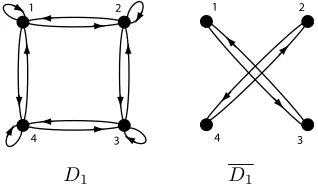
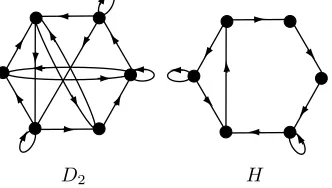
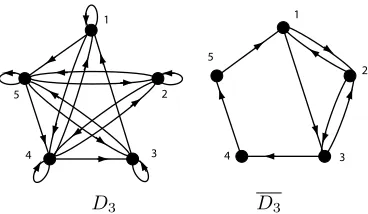
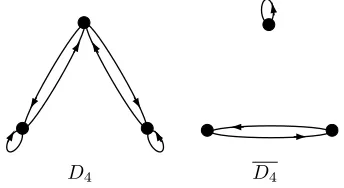
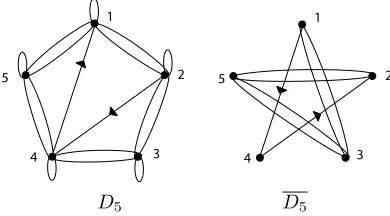
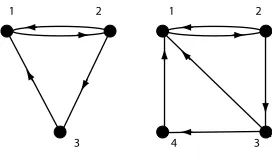
![Fig. 2.7. Order four Q-minimal complements (with names from [11])](https://thumb-ap.123doks.com/thumbv2/123dok/959812.911140/13.612.161.348.282.438/fig-order-q-minimal-complements-names.webp)
